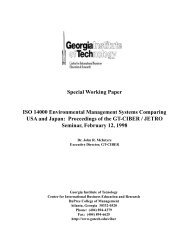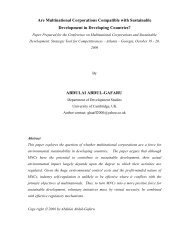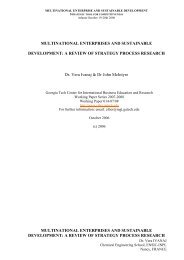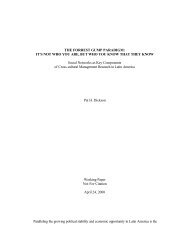AMD vs Intel: Technology, Competition, and Sustainability
AMD vs Intel: Technology, Competition, and Sustainability
AMD vs Intel: Technology, Competition, and Sustainability
Create successful ePaper yourself
Turn your PDF publications into a flip-book with our unique Google optimized e-Paper software.
the PC industry, someone would have sued <strong>and</strong> won. It rose to dominate PC sales but did<br />
not control the industry. <strong>Intel</strong> designed the 8086, but only grew to dominate the x86<br />
compatible industry by moving up-market, <strong>and</strong> cutting prices on the newer more<br />
powerful chips. <strong>AMD</strong> struggled to compete, even though it lost money many years. It<br />
carried out its own R&D program <strong>and</strong> acquired outside firms <strong>and</strong> got substantial<br />
subsidies from Germany <strong>and</strong> Saxony to build Fab 30 in Dresden. It survived, <strong>and</strong> now<br />
has some superior products. It continues to get huge subsidies from Germany. It can sell<br />
more chips than it can make. so it contracts foundry products from IBM <strong>and</strong> Chartered.<br />
<strong>AMD</strong> enjoyed a rise in stock prices from 2003 to 2006 (although though it has since<br />
fallen) while <strong>Intel</strong>’s stock price has trended down since 2001.<br />
The antitrust suits may have helped preserve competition in mainframe computers<br />
for a while, but could not preserve the industry itself. Antirust <strong>and</strong> patent suits against<br />
<strong>Intel</strong>, may have helped preserve competition in the minicomputer industry, but could not<br />
preserve the minicomputer industry. <strong>AMD</strong>’s antitrust suit against <strong>Intel</strong> may preserve a<br />
competitor, but it is only German subsidies that keep <strong>AMD</strong> alive. Without the German<br />
subsidies, <strong>AMD</strong> would have had ten years of losses, but would not have been able to<br />
manufacture the microprocessors the sale of which kept it alive. The antitrust laws did<br />
not prevent IBM from dominating the mainframe industry in the 1960’s <strong>and</strong> 1970’s when<br />
IBM sold about three-fourths of mainframes in the world, <strong>and</strong> the Department of Justice<br />
sued for violating the Sherman Act. Control Data Corporation (one of the “seven<br />
dwarfs”) also sued <strong>and</strong> shared discovery with DOJ. CDC settled for more than a billion<br />
dollars. IBM was smart enough to avoid signing exclusive deals with <strong>Intel</strong> <strong>and</strong> Microsoft<br />
which were able to supply companies making IBM compatibles. It required <strong>Intel</strong> to<br />
license competitors, so clone makers could buy compatible chips. Antitrust law <strong>and</strong><br />
IBM’s forethought prevented <strong>Intel</strong> from monopolizing the PC chip market. During the<br />
past 25 years, antitrust forbade <strong>Intel</strong> from acquiring or destroying <strong>AMD</strong> or from formally<br />
dividing the market with it. There were many times in which a merger or cartel would<br />
have been highly profitable to both corporations. The recent fall in the price of both<br />
stocks <strong>and</strong> chip prices means that active price competition between them has not<br />
benefited <strong>Intel</strong> or <strong>AMD</strong>. A well-behaved duopoly of <strong>Intel</strong> <strong>and</strong> <strong>AMD</strong> would have made<br />
both of them more valuable, but price concessions would have had to be made to the PC<br />
sellers to keep them quiet. Antitrust laws has prevented PC makers from combining <strong>and</strong><br />
forming a bilateral monopolies with the hypothetical chip or software monopolists. As a<br />
result, no one in the microprocessor <strong>and</strong> computer business is making any great amount<br />
of money.<br />
Most of the profit of manufacturing PC’s has been squeezed out over the years by<br />
<strong>Intel</strong> <strong>and</strong> <strong>AMD</strong>’s price structure. It is amazing that both firms in an implicit duopoly can<br />
maintain gross margins of 57 to 60 percent. <strong>Intel</strong>’s recent price-cutting, discounts <strong>and</strong><br />
concessions prompted <strong>AMD</strong>’s antitrust suit against <strong>Intel</strong>. Had <strong>Intel</strong> quietly accepted an<br />
inferior competitive position (as <strong>AMD</strong> did when it produced inferior parts), <strong>AMD</strong> could<br />
have charged premium prices, built its capacity, paid down its debt, <strong>and</strong> piled up profits.<br />
Instead <strong>Intel</strong> launched a strong defensive campaign. The Core 2 Duo was introduced, <strong>and</strong><br />
Apple singed on as a customer. While quality <strong>and</strong> performance issues remain, <strong>Intel</strong> is<br />
building two new giant fabs, hardly a sign of resignation. It has sold off money-losing<br />
8















